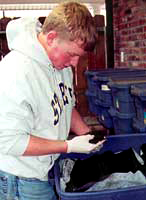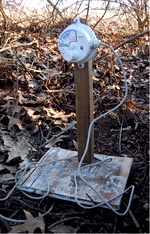
From raw data to rich description:
Young naturalists produce award-winning science essays
"This world, after all our science and sciences, is still a miracle; wonderful, inscrutable, magical and more, to whosoever will think of it."—Thomas Carlyle
On a hot highway in Ohio, a tall teenager with a passion to protect endangered species crouches with a shovel. He's picking up snakes struck by cars in the Killdeer Plains Wildlife Area. Using a pneumatic traffic counter, he works to find the reasons for the numbers of dead snakes in a given season. Along with charts of traffic frequency and graphs of road temperature, he keeps a journal about his expeditions along long, lonely roads.
 Down in South Louisiana, a student keeps litter-boxes clean for his family's ten cats. Disgusted by the task, he lights on the idea of using worms to transform the kitty waste into rich, dark soil—will it work? Will it be safe? He calls the nation's expert on the subject, who isn't entirely sure—then he gets to work building worm bins. He carefully documents each stage of the process with photographs and a log, and leavens his reports with humorous turns of phrase.
Down in South Louisiana, a student keeps litter-boxes clean for his family's ten cats. Disgusted by the task, he lights on the idea of using worms to transform the kitty waste into rich, dark soil—will it work? Will it be safe? He calls the nation's expert on the subject, who isn't entirely sure—then he gets to work building worm bins. He carefully documents each stage of the process with photographs and a log, and leavens his reports with humorous turns of phrase.
And far up the United States' eastern coast, a high school senior on an exposed island in Maine counts periwinkles. These little whorled gastropods with grey and black shells fill her days. She's trying to determine the reasons behind their intertidal placements on different rocks—a subject untouched by previous scientific literature. With a pen always in her pocket, she takes note of the feel of the sun on her skin, the sound of the water in her ears, and the excitement that propels her research.
All three are winners of the Young Naturalist Award, an annual essay contest sponsored by the American Museum of Natural History. The contest celebrates student researchers who turn months of science investigation into superb prose.
Writing across the curriculum
The students who are named Young Naturalists are as different as the research subjects they invent. Drawn nationally from applicants in grades 7-12, they are neither science wonks nor poets. Rather, they use their prose to take the reader along expeditions, and create a sensory world where research springs to life.
The theme of the Young Naturalist Awards is the same every year: "Scientific Discovery Begins with Expeditions!" Students choose a topic in biology, Earth science, or astronomy and take an expedition to an area where they can explore their topic.
"Scientists from the American Museum of Natural History go on many expeditions each year. They go to explore, collect data, and analyze and document their findings," the contest directions tell students. "You do not need to go to an exotic place to observe and collect data. Your expedition can be a class trip, a family vacation, or a visit to your local park, a nearby stream, or your own backyard. As long as you engage in the observation and collection of data, you are on a scientific expedition."
Teachers who want to use the Young Naturalist Awards with their students sometimes make it a semester project and require each student in their class to participate. Others suggest the contest to students in their science clubs or present it as an extra credit project.
In either case, the challenge for teachers and other adult mentors is the same: to bridge the science lab and natural world with writing. Teachers must help their students put the decades-long "writing across the curriculum" into practice. They must show their students that writing has a natural kinship with science-that close observation and innovative thinking fuel both. They must open the classroom to a spirit of expedition in the broadest sense.
Essays that bring the world alive
 The scientists who judge the awards look for more than hard science: they seek evocation of a landscape, the electric suspense of articulate questions, and descriptions of an evolving thought process. Students who win the award explain complex information (chemical changes, taxonomy, equations) in everyday language, as if discussing ideas with a friend.
The scientists who judge the awards look for more than hard science: they seek evocation of a landscape, the electric suspense of articulate questions, and descriptions of an evolving thought process. Students who win the award explain complex information (chemical changes, taxonomy, equations) in everyday language, as if discussing ideas with a friend.
Nathan, the student who pioneered his version of "snaking," writes,
As I was unable to drive during my first two years of "snaking," this project gave me lots of great bonding time with my parents as they drove the 100 miles to, around, and from the wildlife area, allowing me to discuss anything from school to the meaning of life and sometimes even snakes. Nothing builds togetherness like driving 35 miles an hour looking for dead snakes, staying awake by discussing the emotional range of snakes or the symbolism in Queen's Bohemian Rhapsody with your dad.Emily, whose basement turned into a periwinkle research lab, writes,
The tide was low, and the clam flat's odor filled the autumn air. The blue sky was crystal clear, and the rocks were still warm from the noon sun. I heaved a sigh and kicked off my sneakers. The ledge was warm and felt perfect under my toes. I ran barefoot along the rocks, jumping on stepping-stones across the mud flat to my island. I bent low and picked up one of my periwinkles. I hummed to it as I filled my lungs with the fresh air. Then the circuit was completed. The electricity ran as excitement through my veins.And Eric, who spent two years determining if a composting cat pan was a practical idea, writes,[....]
My previous studies suggest that in order for morphologic variation among sites to be effectively compared, the periwinkles' intertidal position must be taken into account. The purpose of the recent study was to further explore the influence of intertidal position and substrate on periwinkle morphology. I formulated a research hypothesis that stated that periwinkle shell height would vary according to intertidal position and substrate. Specifically, periwinkles on ledges near the high tide would be, on average, smaller than those on ledges near the low tide, and periwinkles in tide pools would be, on average, the smallest.
The worms, of course, asked, "What's for dinner?" Since Eisenia fetida manure worms will make use of almost any carbon and nitrogen source as food, the worms were not picky about cat waste. It is a common misconception that worms "eat" waste. The worms get their nutrition from the bacterial, fungal, and protozoal activity in the vermicomposting system. Since the worms have no teeth or digestive enzymes, the microorganisms "predigest" the worm's food and then become food themselves.The fact that the American Museum of Natural History recognizes invigorating intellectual work by young people is cause for celebration. The awards convey the important message that written communication lies at the heart of any successful venture—and that close observation, combined with writing, can be a simple bridge to brilliant discoveries.
The Young Naturalist Awards site welcomes applications for the 2006 contest. For information, click here.
Click below to read excerpts from:
"Got Cats? Get Worms!" by Eric, 17, Louisiana
"Que Vivan Las Serpientes Muertas!" by Nathan, 17, Ohio
"Morphologic Variation in the Common Periwinkle" by Emily, 17, Maine
Click here to read the Young Naturalist Awards rough draft check list and resources to inspire connection with nature and writing
Return to "It's hip to be deep: Making writing essential to teens' lives."